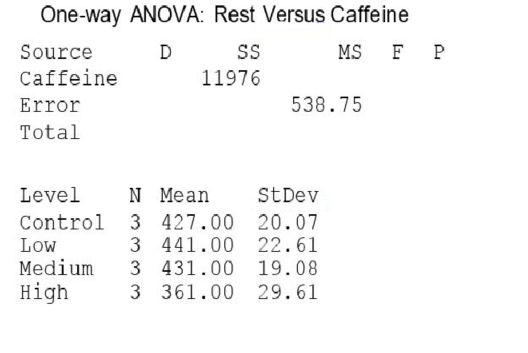Investigators gave caffeine to fruit flies to see if it affected their rest. The four treatments were a control, a low caffeine dose of 1 mg/ml of blood, a medium dose of 3 mg/ml of blood, and a higher caffeine dose of 5 mg/ml of blood. Twelve fruit flies were assigned at random to the four treatments, three to each treatment, and the minutes of rest measured over a 24-hour period were recorded. Assume the data that follow are four independent SRSs (one from each of the four populations of caffeine levels) and that the distribution of the yields is Normal.  A partial ANOVA table produced by Minitab follows, along with the means and standard deviation of the yields for the four groups.
A partial ANOVA table produced by Minitab follows, along with the means and standard deviation of the yields for the four groups. 
The null hypothesis for the ANOVA F test is that:
A) the population mean rest is the same for all four levels of caffeine.
B) the population mean rest is increasing as the caffeine level gets larger.
C) the population mean rest is decreasing as the caffeine level gets larger.
D) the population mean rest is largest for the high level of caffeine.
Correct Answer:
Verified
Q11: Investigators gave caffeine to fruit flies to
Q12: At what age do babies learn to
Q13: Investigators gave caffeine to fruit flies to
Q14: Investigators gave caffeine to fruit flies to
Q15: A company runs a three-day workshop on
Q17: A traffic engineer wanted to study
Q18: A traffic engineer wanted to study the
Q19: Which of the following is a
Q20: A traffic engineer wanted to study
Q21: Many Americans complain about being sleep
Unlock this Answer For Free Now!
View this answer and more for free by performing one of the following actions

Scan the QR code to install the App and get 2 free unlocks

Unlock quizzes for free by uploading documents